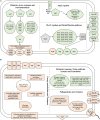Gene Expression Profiling of Pseudomonas aeruginosa Upon Exposure to Colistin and Tobramycin
- PMID: 33995291
- PMCID: PMC8120321
- DOI: 10.3389/fmicb.2021.626715
Gene Expression Profiling of Pseudomonas aeruginosa Upon Exposure to Colistin and Tobramycin
Abstract
Pseudomonas aeruginosa (Pae) is notorious for its high-level resistance toward clinically used antibiotics. In fact, Pae has rendered most antimicrobials ineffective, leaving polymyxins and aminoglycosides as last resort antibiotics. Although several resistance mechanisms of Pae are known toward these drugs, a profounder knowledge of hitherto unidentified factors and pathways appears crucial to develop novel strategies to increase their efficacy. Here, we have performed for the first time transcriptome analyses and ribosome profiling in parallel with strain PA14 grown in synthetic cystic fibrosis medium upon exposure to polymyxin E (colistin) and tobramycin. This approach did not only confirm known mechanisms involved in colistin and tobramycin susceptibility but revealed also as yet unknown functions/pathways. Colistin treatment resulted primarily in an anti-oxidative stress response and in the de-regulation of the MexT and AlgU regulons, whereas exposure to tobramycin led predominantly to a rewiring of the expression of multiple amino acid catabolic genes, lower tricarboxylic acid (TCA) cycle genes, type II and VI secretion system genes and genes involved in bacterial motility and attachment, which could potentially lead to a decrease in drug uptake. Moreover, we report that the adverse effects of tobramycin on translation are countered with enhanced expression of genes involved in stalled ribosome rescue, tRNA methylation and type II toxin-antitoxin (TA) systems.
Keywords: Pseudomonas aeruginosa; RNA-Seq; Ribo-seq; colistin; ribosome profiling; tobramycin.
Copyright © 2021 Cianciulli Sesso, Lilić, Amman, Wolfinger, Sonnleitner and Bläsi.
Conflict of interest statement
The authors declare that the research was conducted in the absence of any commercial or financial relationships that could be construed as a potential conflict of interest.
Figures





Similar articles
-
Antibiotic strategies for eradicating Pseudomonas aeruginosa in people with cystic fibrosis.Cochrane Database Syst Rev. 2023 Jun 2;6(6):CD004197. doi: 10.1002/14651858.CD004197.pub6. Cochrane Database Syst Rev. 2023. PMID: 37268599 Free PMC article. Review.
-
The Effects of Antibiotic Combination Treatments on Pseudomonas aeruginosa Tolerance Evolution and Coexistence with Stenotrophomonas maltophilia.Microbiol Spectr. 2022 Dec 21;10(6):e0184222. doi: 10.1128/spectrum.01842-22. Epub 2022 Dec 1. Microbiol Spectr. 2022. PMID: 36453898 Free PMC article.
-
Multidrug Adaptive Resistance of Pseudomonas aeruginosa Swarming Cells.Antimicrob Agents Chemother. 2020 Feb 21;64(3):e01999-19. doi: 10.1128/AAC.01999-19. Print 2020 Feb 21. Antimicrob Agents Chemother. 2020. PMID: 31844008 Free PMC article.
-
Genomics of Aminoglycoside Resistance in Pseudomonas aeruginosa Bloodstream Infections at a United States Academic Hospital.Microbiol Spectr. 2023 Jun 15;11(3):e0508722. doi: 10.1128/spectrum.05087-22. Epub 2023 May 16. Microbiol Spectr. 2023. PMID: 37191517 Free PMC article.
-
Inhaled tobramycin (TOBI): a review of its use in the management of Pseudomonas aeruginosa infections in patients with cystic fibrosis.Drugs. 2003;63(22):2501-20. doi: 10.2165/00003495-200363220-00015. Drugs. 2003. PMID: 14609360 Review.
Cited by
-
Global transcriptional response of Pseudomonas aeruginosa to UVA radiation.Photochem Photobiol Sci. 2024 Nov;23(11):2029-2044. doi: 10.1007/s43630-024-00649-9. Epub 2024 Oct 29. Photochem Photobiol Sci. 2024. PMID: 39470974
-
Comparative phenotypic and proteomic analysis of colistin-exposed Pseudomonas aeruginosa.Germs. 2024 Sep 30;14(3):246-266. doi: 10.18683/germs.2024.1436. eCollection 2024 Sep. Germs. 2024. PMID: 39776958 Free PMC article.
-
Early posttranscriptional response to tetracycline exposure in a gram-negative soil bacterium reveals unexpected attenuation mechanism of a DUF1127 gene.RNA Biol. 2025 Dec;22(1):1-16. doi: 10.1080/15476286.2025.2521887. Epub 2025 Jul 1. RNA Biol. 2025. PMID: 40534149 Free PMC article.
-
Involvement of Acquired Tobramycin Resistance in the Shift to the Viable but Non-Culturable State in Pseudomonas aeruginosa.Int J Mol Sci. 2023 Jul 18;24(14):11618. doi: 10.3390/ijms241411618. Int J Mol Sci. 2023. PMID: 37511375 Free PMC article.
-
Analysis of Antibiotic Response in Clinical Wound Pseudomonas aeruginosa Isolates: Unveiling Proteome Dynamics of Tobramycin-Tolerant Phenotype.Mol Cell Proteomics. 2024 Dec;23(12):100861. doi: 10.1016/j.mcpro.2024.100861. Epub 2024 Oct 16. Mol Cell Proteomics. 2024. PMID: 39424064 Free PMC article.
References
Grants and funding
LinkOut - more resources
Full Text Sources
Other Literature Sources

